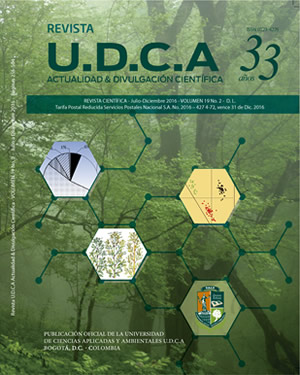Evaluación de la adiponectina y su correlación con la íntima media carotidea en mujeres peri y post menopáusicas hospital de Engativá, Bogotá
Evaluation adiponectin and its correlation with carotid intima media in women peri-and postmenopausal. Engativa hospital, Bogotá
Contenido principal del artículo
Resumen
Palabras clave:
Descargas
Datos de publicación
Perfil evaluadores/as N/D
Declaraciones de autoría
- Sociedad académica
- Universidad de Ciencias Aplicadas UDCA
- Editorial
- Universidad de Ciencias Aplicadas y Ambientales U.D.C.A
Detalles del artículo
Referencias (VER)
ANGELIDIS, G.; DAFOPOULOS, K.; MESSINI, C.I.; VALOTASSIOU, V.; TSIKOURAS, P.; VRACHMIS, N.; PSIMADAS, D.; GEORGOULIAS, P.; MESSINIS, I.E. 2013. The emerging roles of adiponectin in female reproductive system-associated disorders and pregnancy. Reproductive Sciences. 20(8):872-881.
ANTONIADES, C.; ANTONOPOULOS, A.S.; TOUSOULIS, D.; STEFANADIS, C. 2009. Adiponectin: from obesity to cardiovascular disease. Obes. Rev.10(3):269-279.
BLÜMEL, J.E.; LEGORRETA, D.; CHEDRAUI, P.; AYALA, F.; BENCOSME, A.; DANCKERS, L.; LANGE, D.; ESPINOZA, M.T.; GOMEZ, G.; GRANDIA, E.; IZAGUIRRE, H.; MANRIQUEZ, V.; MARTINO, M.; NAVARRO, D.; OJEDA, E.; ONATRA, W.; POZZO, E.; PRADA, M.; ROYER, M.; SAAVEDRA, J.M.; SAYEGH, F.; TSEROTAS, K.; VALLEJO, M.S.; ZUÑIGA, C.; COLLABORATIVE GROUP FOR RESEARCH OF THE CLIMACTERIC IN LATIN AMERICA (REDLINC). 2012. Optimal waist circumference cutoff value for defining the metabolic syndrome in postmenopausal Latin American women. Menopause.19 (4):433-437.
CAGNACCI, A.; PALMA, F.; ROMANI, C.; XHOLLI, A.; BELLAFRONTE, M.; DI CARLO, C. 2015. Are climacteric complaints associated with factors of cardiovascular disease in peri-menopausal women? Gynecol. Endocrinol. 31(5):359-362.
CASTELO-BRANCO, C.; BLÜMEL, J.E.; CHEDRAUI, P.; CALLE, A.; BOCANERA, R.; DEPIANO, E.; FIGUEROA-CASAS, P.; GONZALEZ, C.; MARTINO, M.; ROYER, M.; ZUÑIGA, C.; DULON, A.; ESPINOZA, M.T.; FUTCHNER, C.; MOSTAJO, D.; SOTO, E.; ALBERNAZ, M.A.; ARAVENA, H.; BUSQUETS, M.; CAMPODONICO, I.; GERMAIN, A.; ALBA, A.; BARON, G.; GOMEZ, G.; MONTERROSA, A.; ONATRA, W.; BROUTIN, G.; MANZANO, B.; GABRIELA, A.; HIDALGO, L.; LEON, P.; ORBEA, M.; SANCHEZ, H.; VALLEJO, S.; VALLECILLO, G.; HERNANDEZ BUENO, J.; MOTTA, E.; ANDRADE, R.; TSEROTAS, K.; GONZALEZ, M.C.; BENITEZ, Z.; CALLE, E.; DANCKERS, L.; DEL CASTILLO, A.; IZAGUIRRE, H.; OJEDA, E.; ROJAS, J.; BENCOSME, A.; LIMA, S.; MOTTA, E. 2006. Age at menopause in Latin Ameri- ca. Menopause. 13(4):706-712.
COEMA, A.A. 2011. Las tablas de riesgo cardiovascular: una revisión crítica. MEDIFAM. 11(2):122-139.
COLLINS, P.; ROSANO, G.; CASEY, C.; DALY, C.; GAMBACCIANI, M.; HADJI, P.; KAAJA, R.; MIKKOLA, T.; PALACIOS, S.; PRESTON, R.; SIMON, T.; STEVENSON, J.; STRAMBA-BADIALE, M. 2007. Management of cardiovascular risk in the peri-menopausal woman: a consensus statement of European cardiologists and gynecologists. Eur. Heart J. 28(11):2028-2040.
FRAMINGHAM SCALE. 2010. Disponible desde Internet en: http://www.mdcalc.com/framingham-coronary-heart-disease-risk-score/ (con acceso 22/02/2016).
FUJIHARA, K.; SUZUKI, H.; SATO, A.; KODAMA, S.; HEIANZA, Y.; SAITO, K.; IWASAKI, H.; KOBAYASHI, K.; YATOH, S.; TAKAHASHI, A.; YAMADA, N.; SONE, H.; SHIMANO, H. 2013. Carotid artery plaque and LDL to HDL colesterol ratio predict arteriosclerotic status in coronary arteries in asyntomatic patients with type 2 diabetes Mellitus. J. Atheroscler. Thromb. 20(5):452-464.
FUNAHASHI, T.; MATSUZAWA, Y. 2014. Adiponectin and the cardiometabolic syndrome: An epidemiological perspective. Best Pract & Res. Clin. Endocrinol. & Metab. 28(1):93-106.
GAMBACCIANI, M.; CIAPONI, M.; GAPPAGLI, B.; BENUSSI, C.; DE SIMONE, L.; GENAZZANI, A. 1999. Climateric modifications in body weight and fat tissue distribution. Climateric. 2(1):37-44.
GUPTA, A.; SMITH, D.A. 2014. The 2013 American college of cardiology american hearth association. Guidelines on treating blood cholesterol and assessing cardiovascular risk. Endocrin. Metab. Clin. N. Am. 43(4):869-892.
HARVEST, G. 2009. Biomarkers of adiponectina: Plasma protein variation and genomic DNA polymorphisms. Biomark Insights. 4(1):23-33.
IGLESIA DEL SOL, A.; BOTS, M.L.; GROBBEE, D.E.; HOFMAN, A.; WITTERMAN, J.C. 2002. Carotid intima-media thickness at different sites: relation to incident myocardial infarction; The Rotterdam Study. Eur Heart J. 23(6):934-940.
JOHNSON, B.D.; DWYER, K.M.; STANCZYK, F.Z.; BITTNER, V.; BERGA, S.L.; BRAUNSTEIN, G.D.; AZZIZ, R.; YANG, Y.C.; HALE, G.E.; BAIREY, C.N.M. 2010. The Relationship of menopausal status and rapid menopausal transition with carotid intimamedia thickness progression in women: A report from the Los Angeles atherosclerosis study. J. Clin. Endocrinol. & Metab. 95(9):4432-4440.
KAMPOLI, A.M.; TOUSOULIS, D.; ANTONIADES, C.; SIASOS, G.; STEFANADIS, C. 2009. Biomarkers of premature atherosclerosis. Trends Mol. Med. 15(7):323-322.
KOTANI, K.; CHEN, J.T.; TANIGUCHI, N. 2011.The relationship between adiponectin and blood pressure in premenopausal and postmenopausal women. Clin. Invest. Med. 34(3):E125-E130.
MAC ANANEY, O.; MELLOTTE, G.; MAHER, V. 2014. Comparison of semi-automated and manual measurements of carotid intima-media thickening. Biomed. Res. Int. 531389
ONATRA, W.; GARCÍA, C.; GAMBOA, C.; SÁNCHEZ, J.; CASTRO, J. 2006. Prevalencia del Síndrome Metabólico en mujeres posmenopáusicas en dos centros clínicos de Bogotá. Rev. U.D.C.A Act & Div. Cient.9(1):43-53.
OUCHI, N.; PARKER, J.L.; LUGUS, J.J.; WALSH, K. 2011. Adipokines in inflammation and metabolic disease. Nat. Rev. Immunol. 11(2):85-97.
RECKELHOTFF, J.F. 2004. Basic research into the mechanism responsible for postmenopausal hypertension. Int. J. Clin. Suppl. 139(1):13-19.
ROYER, M.; CASTELO-BRANCO, C.; BLÜMEL, J.E.; CHEDRAUI, P.A.; DANCKERS, L.; BENCOSME, A.; NAVARRO, D.; VALLEJO, S.; ESPINOZA, M.T.; GÓMEZ, G.; IZAGUIRRE, H.; AYALA, F.; MARTINO, M.; OJEDA, E.; ONATRA, W.; SAAVEDRA, J.; TSEROTAS, K.; POZZO, E.; MANRIQUEZ, V.; PRADA, M.; GRANDIA, E.; ZUNIGA, C.; LANGE, D.; SAYEGH, F.; COLLABORATIVE GROUP FOR RESEARCH OF THE CLIMACTERIC IN LATIN AMERICA. 2007. The US National Cholesterol Education Programme Adult Treatment Panel III (NCEP ATP III): prevalence of the metabolic syndrome in postmenopausal Latin American women. Climateric 10(2):164-170.
RUIZ, A.; MORILLO, L.E. 2004. Epidemiologia Clínica: Investigación clínica aplicada. Editorial Panamericana. BogotÁ. p.509.
SOULES, M.R.; SHERMAN, S.; PARROTT, E.; REBAR, R.; SANTORO, N.; UTIAN, W.; WOODS, N. 2001. Executive summary: Stages of Reproductive Aging Workshop (STRAW). Fertil. Steril. 76(5):874-878.
WEBER, C.; NOELS, H. 2011 Atherosclerosis: current pathogenesis and therapeutic options. Nature Medicine. 17(11):1410-1422.
WU, Y.; ZHENG, C.; CHEN, D.; XIE, M. 2015.Investigation of the change of adiponectin level with menopause status in middle aged women and its relationship with androgen. Zhonghua Fu Chan Ke Za Zhi.50(5):356-360.
YANG, W.S.; CHUANG, L.M. 2006. Human genetics of adiponectin in the metabolic syndrome. J. Mol. Med.84(2):112-121.
YAMAUCHI, T.; KAMON, J.; MINOKOSHI, Y.; ITO, Y.; WAKI, H.; UCHIDA, S.; YAMASHITA, S.; NODA, M.; KITA, S.; UEKI, K.; ETO, K.; AKANUMA, Y.; FROGUEL, P.; FOUFELLE, F.; FERRE, P.; CARLING, D.; KIMURA, S.; NAGAI, R.; KAHN, B.B.; KADOWAKI, T. 2002. Adiponectin stimulates glucose utilization and fatty-acid oxidation by activating AMP-activated protein kinase. Nat Med. 8(11):1288-1295.
YIANNIKOURIS, F.; GUPTE, M.; PUTNAM, K.; CASSIS, L. 2010. Adipokines and blood pressure control. Curr. Opin. Nephrol. Hypertens. 19(2):195-200.
ZHANG, B.C.; LIU, W.J.; CHE, W.L.; XU, Y. 2012. Serum total adiponectin level and risk of cardiovascular disease in Han Chinese populations: a meta-analysis of 17 case-control studies. Clin. Endocrinol. 77(3):370-378.







